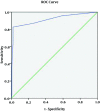Correlation Between Intra-Abdominal Free Fluid and Solid Organ Injury in Blunt Abdominal Trauma
- PMID: 26566511
- PMCID: PMC4636749
- DOI: 10.5812/atr.29184
Correlation Between Intra-Abdominal Free Fluid and Solid Organ Injury in Blunt Abdominal Trauma
Abstract
Background: In previous studies, the diagnostic value of Focused Assessment with Sonography for Trauma (FAST) has been evaluated but few studies have been performed on the relationship between the amount of free intra-abdominal fluid and organ injury in blunt abdominal trauma. To select patients with a higher probability of intra-abdominal injuries, several scoring systems have been proposed based on the results of FAST.
Objectives: The aim of this study was to determine the prognostic value of FAST according to the Huang scoring system and to propose a cut-off point for predicting the presence of intra-abdominal injuries on the Computed Tomography (CT) scan. The correlation between age and Glasgow Coma Scale (GCS) and the presence of intra-abdominal injuries on the CT scan was also assessed.
Patients and methods: This study was performed on 200 patients with severe blunt abdominal trauma who had stable vital signs. For all patients, FAST-ultrasound was performed by a radiologist and the free fluid score in the abdomen was calculated according to the Huang score. Immediately, an intravenous contrast-enhanced abdominal CT scan was performed in all patients and abdominal solid organ injuries were assessed. Results were analyzed using Kruskal-Wallis test, Mann-Whitney test and ROC curves. The correlation between age and GCS and the presence of intra-abdominal injuries on CT-scan was also evaluated.
Results: The mean age of the patients was 29.6 ± 18.3 years and FAST was positive in 67% of the subjects. A significant correlation was seen between the FAST score and the presence of organ injury on CT scan (P < 0.001). Considering the cut-off point of 3 for the free fluid score (with a range of 0-8), sensitivity, specificity, positive predictive value and negative predictive value were calculated to be 0.83, 0.98, 0.93, and 0.95, respectively. Age and GCS showed no significant correlation with intra-abdominal injuries.
Conclusions: It seems that FAST examination for intra-abdominal fluid in blunt trauma patients can predict intra-abdominal injuries with very high sensitivity and specificity. Using the scoring system can more accurately determine the probability of the presence of abdominal injuries with a cut-off point of three.
Keywords: Blunt Trauma; FAST; Free Fluid; Ultrasound.
Figures
References
-
- Ahmadi Amoli H, Zafarghandi MR, Tavakoli H, Davoodi M, Khashayar P. Thoracic trauma: severity of injury in 342 patients. Tehran Univ Med Sci. 2009;66(11):831–4.
-
- Hemmati H, Kazemnezhad-Leili E, Mohtasham-Amiri Z, Darzi AA, Davoudi-Kiakalayeh A, Dehnadi-Moghaddam A, et al. Evaluation of chest and abdominal injuries in trauma patients hospitalized in the surgery ward of poursina teaching hospital, guilan, iran. Arch Trauma Res. 2013;1(4):161–5. doi: 10.5812/atr.7672. - DOI - PMC - PubMed
-
- Khan IA, Ghaffar S, Asif S, Zia ur R, Asad S, Ahmed E, et al. Management of thoracic trauma: experience at Ayub Teaching Hospital, Abbottabad. J Ayub Med Coll Abbottabad. 2009;21(1):152–4. - PubMed
-
- Mefire AC, Pagbe JJ, Fokou M, Nguimbous JF, Guifo ML, Bahebeck J. Analysis of epidemiology, lesions, treatment and outcome of 354 consecutive cases of blunt and penetrating trauma to the chest in an African setting. S Afr J Surg. 2010;48(3):90–3. - PubMed
LinkOut - more resources
Full Text Sources
Other Literature Sources


